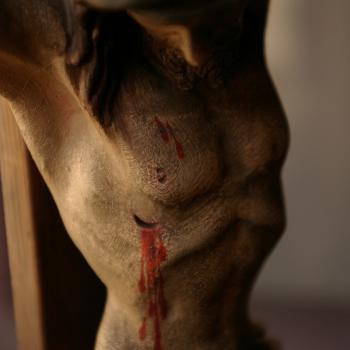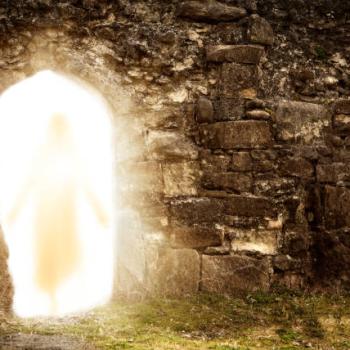I’m interrupting the series “Rowing with Michael through the Old Testament,” as I will about once a week. This time it’s to air a long-standing complaint of mine. It’s somewhat relevant to the last post that touched briefly on creation and science.
Why are some Catholic educators, seemingly the most popular ones, so nervous when it comes to Catholic Bible scholarship? Why are Catholics consigned to a childish notion of the way the Bible teaches? The Church gives her scholars freedom to explore a wide variety of avenues for biblical interpretation. But from homilies to adult workshops to religious education programs for youth, over and over I see outdated and overly literal Bible interpretation and an unwillingness to allow ordinary Catholics to engage with what modern Catholic Bible scholars are saying.
One popular adult catechetical program is “That Man is You.” I joined a group of men in my parish early Friday mornings to learn from this program. It has much to offer, but one episode comes under the above complaint. The presenter hoped to encourage our faith by addressing the issue of creation and science. The creation story in Genesis and the scientific picture of the evolution of the universe seem to be at odds. This issue is not particularly controversial in Catholic Bible scholarship—except to the extent that lack of information about the Catholic position makes it so. But that lack is considerable. For that reason, and because I like science, I was looking forward to what our presenter on DVD had to say.
We were introduced to the work of Dr. Gerald Schroeder, scientist and author of a number of books, including Genesis and the Big Bang. Schroeder attempts to reconcile the biblical account of creation in seven days with modern science. I want to say in advance that this is not what modern scholars do, nor do they think it’s necessary. Still, I want to give due attention to what this man has to say.
Schroeder’s tactic is a variation on interpreting “days” as “ages” – stretching the week of creation out to the current scientific estimate of 13.8 billion years. I learned this way of looking at the days of creation as early as the 1950’s and heard it again recently from a friend who belongs to the conservative Missouri Synod of the Lutheran Church. With a little metaphorical imagination you can see a day as an age. Look close and you can also see that the interpretation doesn’t work. It isn’t just the length of time; it’s the order in which things come to be. The Bible’s order is nothing like what science says.
Or is it? Dr. Schroeder tries to make the idea work. He asks us to look deeper.

Time, according to the Theory of Relativity, is relative. It bends and stretches. In particular, gravity slows time down. A year, one complete orbit of the earth, is 16 seconds slower if you’re standing in the strong gravity of the sun than if you’re on the earth. Going back to the beginning, with all the universe condensed into a primordial “atom,” gravity is enormous and time proportionally very slow. The first day, then, is calculated to cover about eight billion of our years; and it’s not even a metaphor. It’s just a relativity-expanded day. In that span, about 200 million years on (by our time) from the Big Bang, the first stars began to shine—suffusing the universe with light for the first time. And the Bible says God created light on Day 1.
Moving on to Day 2, in the Bible story God makes the sky, under which earth awaits further developments. Scientifically, we have the formation of the sun and the earth. That’s about 4 and a half billion years ago from our point of view, but according to Schroeder only the second 24-hour period, if you were around then, or from God’s point of view.
These first days stretch across a wide swath of time, but that swath gets smaller with each passing day as the universe expands and gravity weakens. The earth gradually cools, rain reaches the ground and stays in the form of water. Oceans are formed, and it’s Schroeder’s Day 3. Day 3 in the Bible happens to be the day when God separates the dry land and the water. Here we have to use a little interpreting freedom. The Bible’s idea is to make dry land appear out of what had been all water, the reverse of what science says. But we end up with land and oceans either way, so let’s go on.
On Day 4 Genesis says God makes the sun, moon, and stars. Scientifically, this is the “day” during which the first primitive life, one-celled algae, evolves. Schroeder sees a connection. Algae produces oxygen and changes the earth’s atmosphere so that it’s clear enough to see through. That means the sun, moon, and stars can now appear in the sky. We have to interpret again. The Bible say God made the sun, moon, and stars, but that turns out to be just making them appear. By taking this liberty the theory gets past one big scientific problem with the Bible’s order of creation, green plants growing on the earth (day 3) before the sun ever shows up (day 4).
Life continues to evolve in the oceans until we get the first sea creatures on the fifth science “day”, and on the Bible’s Day 5 God creates the creatures that swim in the sea. There are no birds yet in science’s view; they don’t evolve until after the dinosaurs. That’s another problem because the Bible says the birds were created on the same day as the fish. But winged insects have evolved, so we have to substitute them for the birds.
Finally, life crawls out of the oceans; we get crawling, running, jumping creatures on land, including people. It’s Day 6, and by now time is flowing about the way it does today.
A remarkable system, but there are some problems with it—scientific, pastoral, and theological. Some science problems have been noted already—the sun only appearing on the fourth day instead of being created then and birds masquerading as insects. But the biggest problem is water. It’s not just the ocean that rolled before land appeared. According to the Bible water was around from the very beginning. There’s no water at the time of the Big Bang, but in the Bible huge expanses of water surround the little world that God creates. A biblical metaphor perhaps? In the Bible water symbolizes chaos, but Schroeder doesn’t try to fit chaos into the picture, and I don’t know how he could.
Pastorally, I worry about this theory the same way I’m uneasy with any attempt by religion to claim scientific validity. Some of the men in my group thought it’s good if an interpretation like this can help some people to believe in the Bible. But science changes. Theories come and go, and when this one goes, if it does, what happens to the person’s faith that found support in this theory? The Internet is loaded with people who have turned against their faith because some scientific or historical facts contradicted what they were taught was God’s revelation. It’s pastorally dangerous to be teaching that the Bible’s revelation includes this or any other point of a passing age’s science.
The most important problem is theological, and it’s here I will claim that this way of interpreting Genesis is simply not Catholic. The theory imputes a kind of knowledge to the ancient writers of the stories in Genesis that they could not possibly have acquired. Or it proposes a kind of revelation in which God infuses utterly foreign ideas into those writers or even dictates the Bible’s words with the humans merely acting as recording machines. This is a very fundamentalist view of God’s word.
Catholics believe that Jesus, the Word of God in person, is both fully human and fully divine and that the Bible is the same. The fundamentalist view of revelation makes the Bible totally divine and hardly human at all. On the contrary, the Catechism of the Catholic Church says the words of God in the Bible “are in every way like human language.” (101)
To compose the sacred books, God chose certain men who, all the while he employed them in this task, made full use of their own faculties and powers so that, though he acted in them and by them, it was as true authors that they consigned to writing whatever he wanted written, and no more. (106)
Back to my complaint at the beginning of this piece. Catholic scholars, since at least the 1940’s, have been at the forefront of modern biblical interpretation, with the approval of the Church. Maybe Catholic educators know what the Church teaches and her scholars have discovered. Maybe they know that the Creation Story is a theological poem or that the Flood Story is an old myth reworked and improved theologically by an unknown biblical author. But they seem to think such literary genres in the Bible are too dangerous to handle.
School children are learning about literary genres as early as second grade. Will we lose our faith if we start seeing what a great variety of those genres exists in the Bible? I think the danger is exactly the opposite. We are not going to stop being modern people just so we can keep our understanding of our faith at a pre-second grade level.
There is history in the Bible, but there is also historical fiction, legend, a humorous tall tale, made-up stories, and re-workings of stories from other cultures—and mistakes and disagreements and developments. These are some of the ways that humans arrive at and communicate important truths, and, as I like to tell my Confirmation classes, God is OK with that. God settles down right in the middle of all that human stuff.
There is also a beautiful poem at the beginning of the Book of Genesis that tells important truths about God, God’s relation to the world and us, and our relation to God and the world and each other. And it has no modern science in it. That is what Catholics, young and old, should be taught, not some clever way to squeeze modern science into the ancient words of the Bible.












